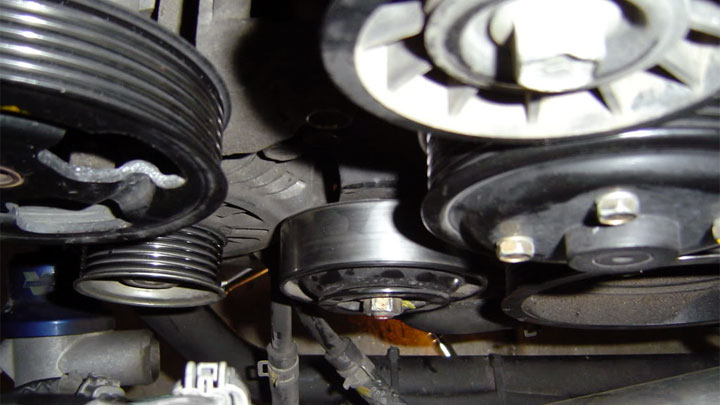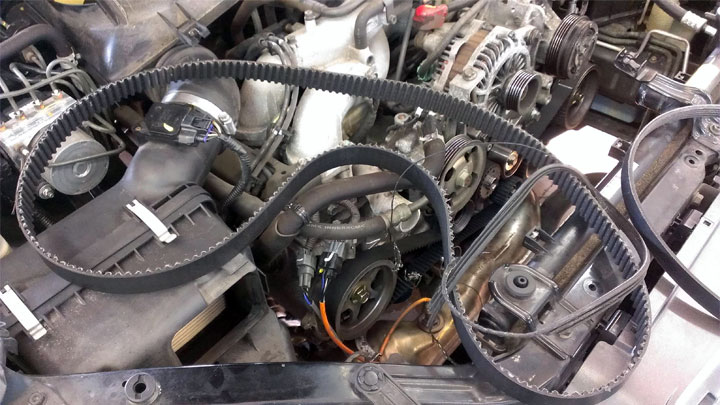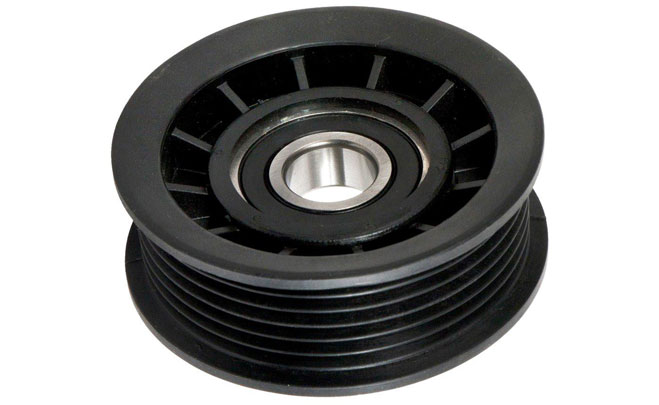5 Causes of Idler Pulley Noise (and Replacement Cost)
Serpentine belts rely on idler pulleys gliding smoothly without interference. But over time, wear takes a toll, with noise becoming a signal for impending idler pulley problems.
Address the minor sounds now before you’re looking at a costly repair bill. We’ll go over the common causes of idler pulley noise, how to pinpoint the culprit, and replacement costs to expect.

What Is an Idler Pulley?
An idler pulley is a small wheel that’s used to guide a drive belt in your car’s engine. It doesn’t drive anything directly, it just changes the direction of the belt.
They’re simple little parts but very important in making sure that your serpentine belt runs smoothly.
Common Causes of Idler Pulley Noise
When you hear a noise coming from the idler pulley, it can usually be attributed to one of three causes. Your pulley may wear out, slip, or be damaged altogether. Below is a description of each of these causes in the order that you can expect them to occur.
It is important that you pay attention to the noises because they can go from bad to worse. The lighter noise you hear from the first cause should be enough reason to have your vehicle checked by a mechanic.
Otherwise, the noises will get worse and then lead to more serious problems which will cost you a lot more money to get fixed.
#1 – Pulley Old and Worn Out

The idler pulley is constantly spinning along with the drive belt. This creates wear and tear on the pulley after years of doing this repeatedly.
The pulley will develop scuffs and other marks on its surface when this occurs. This is when the noises will begin, although they will be less noticeable noises at this point.
#2 – Bearing Issues
If you hear a chattering, chirping, or squealing noise in your car, it’s likely due to bearing issues in the idler pulley.
Over time, bearings are subjected to wear and tear, causing them to loosen, seize up, and overheat. This can result in an unwelcome noise every time you start your engine.
#3 – Pulley Slippage

Idler pulley slippage is likely to follow after it becomes worn out enough. This will cause the pulley to bind and then rub against the engine belt. As a result, there will be squealing noises coming from the engine area that will only get worse until the pulley is replaced.
Not only that, it may also cause other belts and components within the engine to become worn and damaged too.
#4 – Pulley Damage

In extreme situations where the first two causes of idler pulley noise are ignored, the idler pulley will get damaged and ultimately break altogether. The pulley will form cracks and start to break apart a little bit at a time. This will create a chain reaction where the serpentine belt start to tear or completely breaks.
If this happens, then you will have a lot of problems coming from the engine, like stalling and overheating. On top of that, you will have an even louder squealing noise that will be consistent and annoying to everyone in the car and the immediate surrounding area.
#5 – Serpentine Belt Problems
Your engine relies on the serpentine belt to power essential components, such as the alternator, water pump, and power steering pump. However, a worn or damaged serpentine belt can slip and make squealing noises. This could be caused by the idler pulley, which helps keep proper tension on the belt.
To avoid further complications, regularly check the serpentine belt for signs of wear, such as cracks or uneven wear. If you spot any issues with the belt, consider taking your car to an independent repair shop or dealership service center for a replacement.
Idler Pulley Replacement Cost
Best places to order parts? See: 19 Best Online Auto Parts Stores

The cost to replace the tensioner pulley of your driver belt will usually be somewhere between $80 and $200. The cost for the new part should only be anywhere from $40 to $90, while the cost of the labor will be anywhere from $40 to $110. These prices do not include added taxes and fees charged by the auto shop.
Overall, this replacement job is not that expensive to get done. Since the drive belts of the engine are dependent on the idler pulley, you cannot afford to postpone replacing this part after it gets worn out.
Is It Ok to Continue Driving With a Faulty Idler Pulley?
While driving with a bad idler pulley isn’t exactly dangerous, it’s really not a good idea. The main reason is that it can cause further damage to your vehicle.
You might experience a constant squeaking sound coming from your motor that gets louder with higher RPMs, which is a sign that there’s an issue with the idler pulley. Not only is this annoying, but the wear and tear on the pulley’s surface or a seized/loose bearing can put additional stress on the drive belt and other components.
When that happens, a relatively cheap repair can become much more.
Diagnosis of Idler Pulley Noise
Visual Inspection
Before diving into technical stuff, it’s always a good idea to start with a basic visual inspection. Pop open the hood and take a close look at the engine bay. Examine the engine pulleys, particularly the idler pulley, for signs of wear or damage.
Watch out for pulley grooves that may be worn, a torn belt, or any signs of belt slippage. Also, keep an eye out for any coolant or antifreeze exposure to the pulleys and belts, as it could cause damage and prompt unusual noises.
Sound Identification
Now, let’s focus on identifying the specific noise your idler pulley might be making.
A common symptom of a bad idler pulley is a chirping or chattering sound coming from the engine bay. This noise could be more noticeable during cold weather, as a frozen or stiff bearing may cause the pulley to generate such a sound.
To pinpoint the noise source, start your engine and listen carefully. As you vary the engine speed, pay attention to any changes in the noise. If it increases with engine speed or gets louder when using the air conditioning, the idler pulley could be the culprit.
Check for Excessive Play
Finally, check the idler pulley for any play. Gently wiggle the pulley back and forth to feel if there’s any looseness. A worn or damaged pulley might cause unwanted play, leading to that annoying chirping noise in your engine bay.
Taking Preventative Measures
Proper Tensioning
One of the easiest ways to avoid idler pulley noise is by making sure your vehicle’s belt system has proper tensioning. Serpentine belt noise can be caused by a bad tensioner or worn bearing in the pulley.
Regularly check your belt system for looseness and adjust the tension accordingly. A tight belt will help the pulley apply the right torque, preventing belt squealing and stalling.
But keep in mind that too much tension can wear out the bearings, leading to friction and a damaged pulley. Pay close attention to the manufacturer’s recommendations and consult an experienced mechanic if you’re not sure about the appropriate tension levels.
Regular Maintenance
To prevent idler pulley noise (and many other issues for that matter), you’ll want to commit to regular maintenance of your vehicle.
In this instance, start by checking if the mounting bracket for the idler pulley is in good condition. Warped or damaged brackets can cause issues in the belt system, which may lead to undesirable noises.
Here are a few additional maintenance tips:
- Inspect the idler pulley for scuffs, wear marks, and corrosion. A corroded surface can contribute to belt squealing and overall poor performance.
- Listen for chattering, squealing, or chirping sounds, as these could indicate issues with the pulley bearings or belt system.
- Regularly check your vehicle’s belts for cracks, fraying, or other signs of wear. Replace them as needed.
- Lubricate the bearings in the idler pulley if necessary. This can help reduce friction and prolong the life of the component. However, be cautious not to over-lubricate, as this can inadvertently cause slippage and squealing.
- Replace the Engine or Replace the Car? (11 Factors to Consider) - Apr 11, 2024
- Plastic Piece Dragging Under Your Car? (What It Is and What To Do) - Mar 21, 2024
- Timing Belt vs Timing Chain (What’s the Difference?) - Feb 27, 2024

I have a 2016 Chevy Sonic. 1.8 l
. I hear a metal to metal grinding noise from the front of my engine. When I go above 45-50 mph I really don’t hear it . There is also a wining noise when I accelerate but it shifts well. No problem climbing hills. No overheating and no leaks. Can someone help me diagnose.
Inspect the serpentine belt, crankshaft pulley, and all accessory pulleys. Make sure there is no contact between any of these moving parts and another part of the engine. Can you pinpoint the sound to one area of the engine bay?
I have a loud squeak noise when truck starts eventually stops after being on for so long. Sound had gotten louder though
Can you tell where the sound is coming from?
I hear a loud noise in my car when my air conditioner is on
But when I turn it off,I don’t hear it,can you help me,please???
Can you please describe the loud noise? Otherwise I’m completely guessing as to what the problem is.
If it’s a loud squeal, your serpentine belt could be loose. If your serpentine belt is in bad shape (cracks or broken ribs), you should just replace it entirely.
i hear a squeaking or groaning noise when i start my toyota corolla 2010 model and drive for about 5minutes.the noise therefore increases but reduces when i stop the car
Can you tell where the groaning noise is coming from? Does it increase with engine RPM or as you drive faster? Does turning the steering wheel change anything?
Hello, I have a 2001 Mercury grand Marquis and my idler pulley just seized up, I immediately drove car home which wasn’t far at all driving it easy and it did not overheat, but after I parked it, I noticed coolant leaking under the engine area, again the engine did not overheat and it looked like the coolant was leaking from a hose behind the water pump so not sure it was damaged or anything else damaged.
You’ll need to pinpoint the exact location of the coolant leak before driving too much further. It could simply be a coincidence, but since the idler pulley failed I am inclined to believe the coolant is coming from the weep hole on the water pump.
Water pumps are designed with a weep hole to inform you the seal is leaking and the water pump is nearing its failure point. It’s best to address this as soon as possible so you don’t overheat the engine.
Before driving again, make sure your coolant is topped up. Check the overflow reservoir to make sure the coolant is at the proper level. Once the engine has cooled completely, check to make sure there is enough coolant in the radiator as well. If you don’t have coolant on hand, you can use distilled water.
Never open a radiator when the engine has been running, as the coolant will be very hot and under pressure! Allow the car to cool completely before touching the radiator cap.